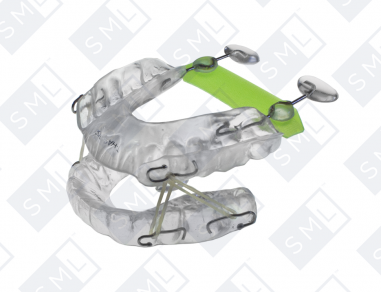Treatment Options: Sleep Appliance Therapy
Because every patient is different, here are some sample combination approaches for your consideration:
The Aligner Sleep Appliance™ (ASA) and the DNA Appliance
I think it’s fair to say that there is a direct correlation between malocclusion and sleep apnea. Research will back me up on this. Those of you who are treating malocclusion patients –aligner or adult patients -- with an appliance approach, need to evaluate those patients for sleep apnea. They may be your orthodontic patients, but you should also view them as potential sleep patients.
Luckily for those undergoing alignment therapy, we have an appliance – the ASA -- that can be utilized during alignment treatment and will allow you to treat that patients apnea concomitantly. Not only will you be improving the size of their arches and their intraoral volume, you also will be helping them sleep better during the treatment.
For those of you doing orthodontic appliance therapy with adult patients, a DNA appliance (and it’s partner appliance the mRNA appliance) are both known to be successful at treating their apnea as well.
If you’re treating a patient for bruxism, TMJ or any condition somewhere within the spectrum of joint dysfunction – pop/click, pain, etc., it’s in your best interest to exercise caution when prescribing a splint/orthotic without testing them for a sleep disorder. Numerous articles and investigtions confirm a definite link between bruxism and sleep apnea. And although the research is ongoing, it’s pretty clear that a high percentage of the bruxing population will also suffer from sleep apnea.
Designed to stop bruxism and reposition the mandible, the Lamberg™ SleepWell may be the ideal solution for a bruxer.
The FULL BREATH™ SOLUTION ZYPPAH™
Many doctors will swear that it is better to control the tongue without venturing into Mandibular Repositioning Appliances They change the occlusion. They just do.
For patients with a large tongue, mandibular advancement may not be successful enough. Sometimes tongue retention is preferable for correcting what is wrong and saving an apnea patient a lifetime (likely a shorter lifetime -- with all the conditions that may accompany or be the result of apnea). If a patient experiences pain with a MAD, a tongue-retaining device or combination therapy appliance may be the way to go. The Full Breath Solution™ and Zyppah™ Appliances provide the greatest promise for such approaches.
In many cases, the expectation that you might get everything done with a single appliance approach -- or that one size fits all and all you have to do is put the thing in your patient’s mouth – is foundational to why we experience a 50% success rate as opposed to a 90% success rate. You can improve your success rate if you take a close look at both appliance potentiality and pre-existing patient conditions -- the full patient landscape, variables and all -- and select an approach that will work best for the patient.
The goal, simply stated, is to open the airway and keep it open. Whatever it takes. Taking into consideration appliance characteristics and patient parameters, try and get as close as possible to the appliance – or combination approach -- that you think is going to work.
For more on the range of available sleep appliances for all types of sleep appliance therapy, be sure to access and review our extensive sleep section at: SMLglobal.com.
Or call us at 800-423-3270 to schedule a 30-minute Powerpoint presentation or custom webinar/workshop detailing how our sleep experts and appliances can help you integrate sleep therapy into your growing practice.
To Download a Free Copy of our Guide to Sleep Success PDF, Click Here.









